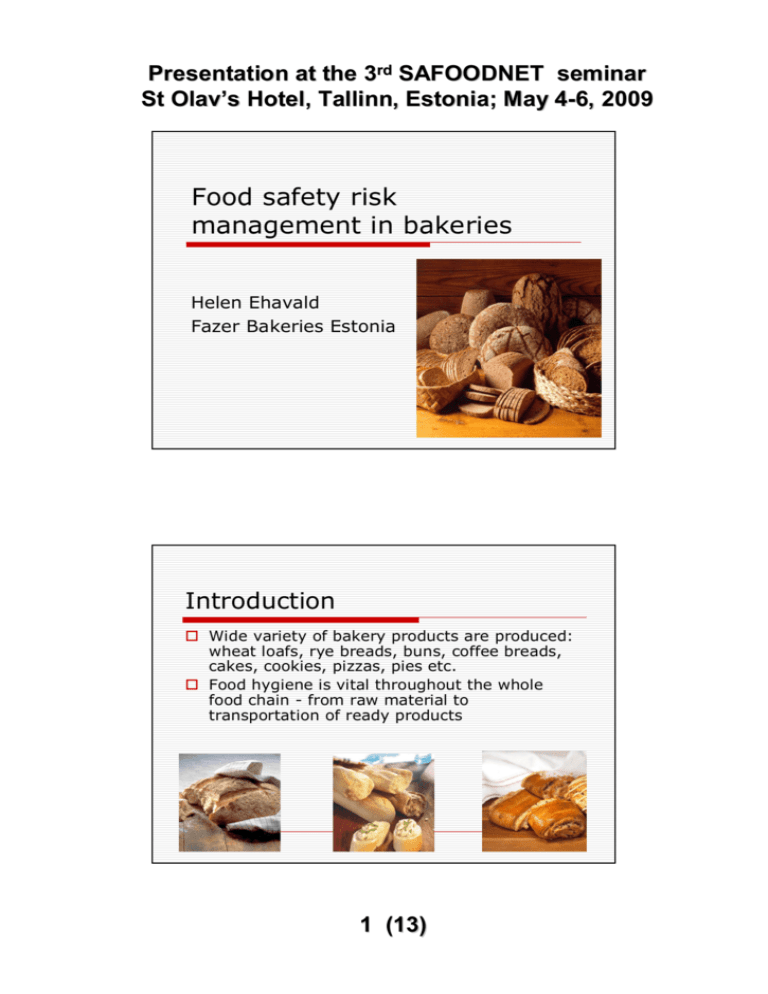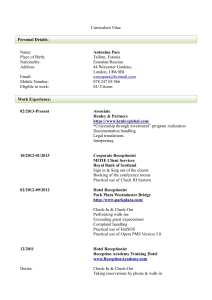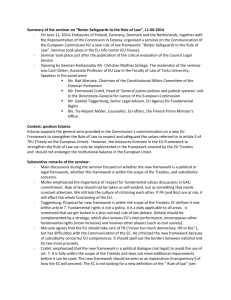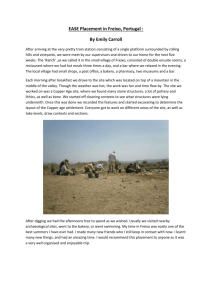Food safety risk management in bakeries
advertisement

Presentation at the 3rd SAFOODNET seminar St Olav’s Hotel, Tallinn, Estonia; May 4-6, 2009 Food safety risk management in bakeries Helen Ehavald Fazer Bakeries Estonia Introduction o Wide variety of bakery products are produced: wheat loafs, rye breads, buns, coffee breads, cakes, cookies, pizzas, pies etc. o Food hygiene is vital throughout the whole food chain - from raw material to transportation of ready products H. Ehavald 1 (13) 2 Presentation at the 3rd SAFOODNET seminar St Olav’s Hotel, Tallinn, Estonia; May 4-6, 2009 Food safety management o Food legislation (Local and EU legislation) o Good Manufacturing Practices (GMP), Good Hygiene Practices (GHP) o HACCP (Hazard Analysis and Critical Control Point) o Quality management system (ISO 9001, ISO 22000, BRC, other) H. Ehavald 3 Product contamination o The main routes of contamination – surfaces, air, water, people and pests o Physical contamination - pieces of glass, wood, metal, plastic, film, human hair and fingernails, plasters, jewellery, small personal belongings, pests, paper, cardboard. o Chemical contamination - residues of cleaning and disinfection chemicals, machinery lubricants, synthetic preservatives, food additives, pesticides o Biological contamination –microbiological (bacteria, yeasts, mould, mycotoxins) and pests H. Ehavald 2 (13) 4 Presentation at the 3rd SAFOODNET seminar St Olav’s Hotel, Tallinn, Estonia; May 4-6, 2009 Microbiological contamination o Spoilage of most bakery products is caused mainly by moulds, yeasts and seldom by bacteria o Most bakery products, in general, are not considered as high-risk food products because baking at relatively high temperatures (around 180-250 C) is involved in their preparation o Many bakery products have reduced water activity (aw) and pH, which prevent the growth of microorganisms o Potentially hazardous foods have a pH >4.5 and an aw>0.84. H. Ehavald 5 pH Range of Selected Bakery Products (Cauvain et al., 1999) o High Acid Sourdough bread 4.2–4.6 Apple pie 4.2 o Low Acid White bread 5.7 Whole wheat bread 5.6 Chocolate nut bread 6.2– 6.6 o Non-Acid Crumpets 6–8 Banana nut bread 7.2–7.9 H. Ehavald 3 (13) 6 Presentation at the 3rd SAFOODNET seminar St Olav’s Hotel, Tallinn, Estonia; May 4-6, 2009 Range of Water Activity (aw) of Selected Bakery Products (Cauvain et al., 1999) o Low Moisture Content Cookies 0.2–0.3 Crackers 0.2–0.3 o Intermediate Moisture Content Cake type doughnuts 0.85–0.87 Chocolate-coated doughnuts 0.82–0.83 Danish pastries 0.82– 0.83 Cream-filled cake 0.78– 0.81 Soft cookies 0.5–0.78 o High Moisture Content Bread 0.96–0.98 Pita bread 0.9 Yeast-raised doughnuts 0.96–0.98 Fruit pies 0.95–0.98 Carrot cake 0.94–0.96 Custard cake 0.92–0.94 Cheesecake 0.91–0.95 Butter cake 0.9 Pizza crust 0.94–0.95 Pizza 0.99 H. Ehavald 7 Microbiological contamination o o o o Flour contains approximately 8000 mould spores in 1 g. The most common bread spoilage moulds are Penicillium spp. and Aspergillus spp. Both can produce mycotoxins (Ochratoxin A and Aflatoxin), which are very resistant and can survive heating process Rhizopus (nigricans) stolonifer is the common black bread mould H. Ehavald 4 (13) 8 Presentation at the 3rd SAFOODNET seminar St Olav’s Hotel, Tallinn, Estonia; May 4-6, 2009 Microbiological contamination o Bacillus subtilis and Bacillus licheniformis can cause ropiness in wheat bread, but rope is now rare because of adding preservatives and good bakery hygiene practice o Bacillus cereus may survive baking process, because Bacillus species can form endospores o A major reservoir of Staphylococcus aureus are humans and some outbreaks have been involved with bakery products (for example filled pies) o Listeria monocytogenes (bakery products containing dairy ingredients), Salmonella spp. (cake mixes made with dry eggs). H. Ehavald 9 Microbiological contamination o It is very important to keep the cold chain of frozen bakery products o Many ingredients, such as fresh and synthetic cream, cold custard, icings, spices, nuts, and fruit toppings or fillings, are added after baking and may be a potential source of contamination. o Using preservatives (sorbic acid, calcium propionate), sourdough, modified atmosphere packaging (MAP), vacuum packaging, microwave and infrared radiation are methods to control the microbiological spoilage. H. Ehavald 5 (13) 10 Presentation at the 3rd SAFOODNET seminar St Olav’s Hotel, Tallinn, Estonia; May 4-6, 2009 MAP o Modified atmosphere packaging (MAP) using CO2-enriched gas atmospheres can extend the mold-free shelf-life and keeping quality of a wide variety of bakery products stored at ambient temperature. o Because S. aureus can grow facultatively, MAP will not inhibit its growth or enterotoxin production H. Ehavald 11 Raw materials o o o o o o o Quality and safety of baking ingredients –flour, yeast, other ingredients Cold-chain for fast-spoiling ingredients (transport) Visual control (broken and dirty package, shelf life) Controlling the temperature of fast-spoiling ingredients Quality sheets and certificates Safe handling and storing FIFO (First in, first out) principle H. Ehavald 6 (13) 12 Presentation at the 3rd SAFOODNET seminar St Olav’s Hotel, Tallinn, Estonia; May 4-6, 2009 Cleaning and sanitation programs o o o o Documented and monitored programs for building, utilities, plant and all equipment Appropriate, effective and regular cleaning methods Cleaning and sanitation materials –where appropriate, confirmed suitability for food use An average shelf life of bread is 3-5 days, but if the hygiene and sanitation of a bakery is poor, the shelf life of bread, especially some wheat bread, can be shorter H. Ehavald 13 Cleaning and sanitation programs o Proofing cabinet needs to be cleaned regularly, because proofing conditions (temperature 30-40 C and humidity 60-80 %) are appropriate for the growth of bakery yeast, but also for moulds. o Conveyor belts, cooling conveyors –regular cleaning is needed! o It is recommended to disinfect slicing and packing machines H. Ehavald 7 (13) 14 Presentation at the 3rd SAFOODNET seminar St Olav’s Hotel, Tallinn, Estonia; May 4-6, 2009 Disinfection o According to literature Benzalkonium chloride was efficient against most fungi. o Some fungi (P. roqueforti and P. carneum) showed to be resistant towards alcohols, but 3% hypochlorite efficiently eliminated them. o Quaternary ammonium compounds, 70% ethanol, 70% isopropanol and 30% hypochlorite were effective on yeasts. o It is suggested to use different types of disinfectants at the same time to prevent resistance problems. o Problems with mould usually occur more in spring and summer. H. Ehavald 15 Personal Hygiene o o o o o o o o o o Documented hygiene rules communicated to all personnel Regular and effective hand washing (before starting work, regularly during work, after eating/smoking/using toilet) Appropriate and clean clothing is critical to the safety of products Jewellery and watches shall not be worn All cuts and grazes on skin should be covered with coloured plaster (blue where possible) Fingernails –short, clean, unvarnished Scalp hair should be fully covered Gloves (blue where possible) It is permitted to work while being sick! Rules for mechanics, subcontractors and visitors H. Ehavald 8 (13) 16 Presentation at the 3rd SAFOODNET seminar St Olav’s Hotel, Tallinn, Estonia; May 4-6, 2009 Pest Control o o o o o Birds, insects and rodents are potentially a major contamination problem in bakeries Appropriate design of production building, ceilings and walls –to keep pest out and not allow them to live there Written preventive pest control program and regular inspection for all areas of the site to minimize pest infestation Flour dust spreads easily everywhere regular cleaning is very important! Silos, ingredient dosing systems, mixers, curling chains, conveyor belts, ovens, cooling conveyors, packaging machines, walls etc. should be properly cleaned to prevent infestation outbreaks H. Ehavald 17 Pest control o Fumigation for silos –a method of pest control that completely fills an area with gaseous pesticides - or fumigants - to suffocate or poison the pests within o Pheromone insect trap o UV lamps –electric trap for flying insects o Insecticides - a pesticide used against insects in all developmental forms o Rodenticides - pest control chemicals intended to kill rodents (should be used outside of building) H. Ehavald 9 (13) 18 Presentation at the 3rd SAFOODNET seminar St Olav’s Hotel, Tallinn, Estonia; May 4-6, 2009 Pest control H. Ehavald 19 Process control o Foreign body detection sieves, magnets, metal detectors, x-ray detectors o Control of preservatives and food additives - the use of preservatives and food additives should be under control o Process control –baking temperature, cooling time o Control of cooling and freezing temperatures H. Ehavald 10 (13) 20 Presentation at the 3rd SAFOODNET seminar St Olav’s Hotel, Tallinn, Estonia; May 4-6, 2009 Process control o Microbiological samples from production air, water, product, equipment, crates and hands of employees. o Raw material, pies, pizzas and cakes should be stored according to the instructions and kept in fridge if needed o More than 90% of contamination of bread occurs during cooling, slicing or wrapping operations. H. Ehavald 21 Process control H. Ehavald 11 (13) 22 Presentation at the 3rd SAFOODNET seminar St Olav’s Hotel, Tallinn, Estonia; May 4-6, 2009 Equipment and maintenance o o o o o All equipment should be constructed of appropriate materials and have a suitable design so that they can be effectively cleaned Buildings (floors, walls, ceiling, non-contact surfaces) should be maintained to minimize the risk of product contamination Regular maintenance program for equipment to prevent product contamination by foreign bodies arising from equipment failure Paints and lubricants shall be suitable for intended use Cleaning of ventilation system (tubes, filters) – inside and outside surfaces H. Ehavald 23 Training o Food hygiene training for bakers, packers, other operators, warehouse workers, mechanics, supervisors, cleaners, dispatch workers, drivers o Understanding of HACCP, CCP-s (Critical Control Points), critical limits, GMP, GHP o Cleaning and sanitation process o Housekeeping rules o Employees should be trained to understand the risk associated with cross-contamination from raw foods and dirty surfaces coming into contact with equipment, clean surfaces and ready product H. Ehavald 12 (13) 24 Presentation at the 3rd SAFOODNET seminar St Olav’s Hotel, Tallinn, Estonia; May 4-6, 2009 Storage and transport o o o o o o Procedures to guarantee product safety during storage, loading and transportation Cleanliness of storage areas and vehicles Controlling temperatures, cold-chain (Frozen bakery products) Use of castors or pallets under crates Do not leave products outside - BIRDS! Maintenance for vehicles H. Ehavald 25 Conclusions o Food safety risk management in bakeries is to implement practices based upon food storage and handling, cleaning and sanitation, pest control, personal hygiene, maintenance program, safe transportation etc. H. Ehavald 13 (13) 26






